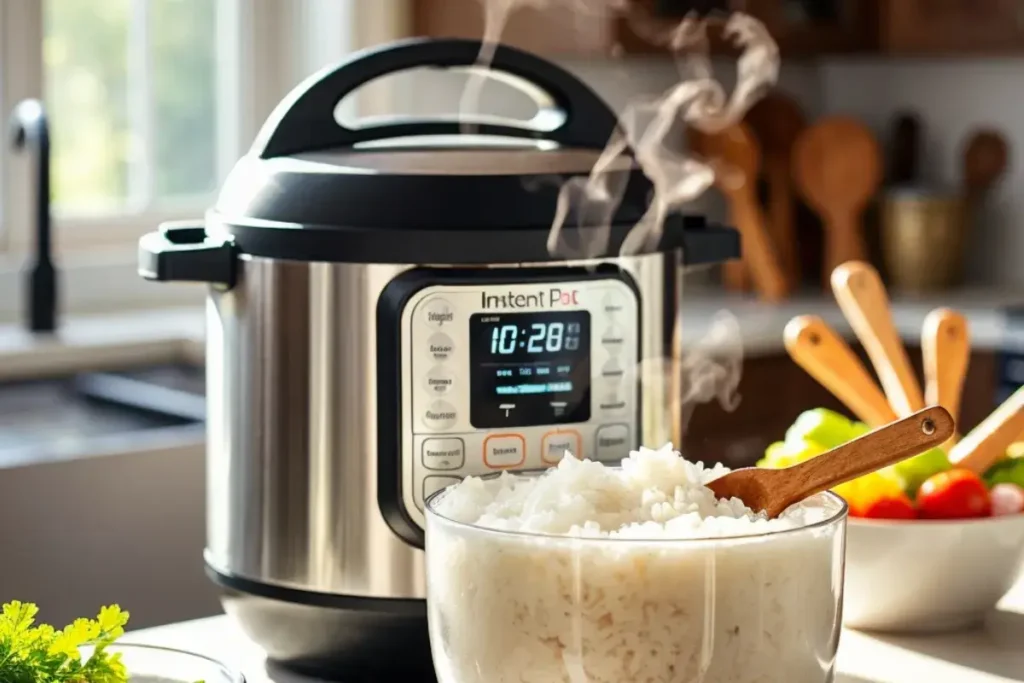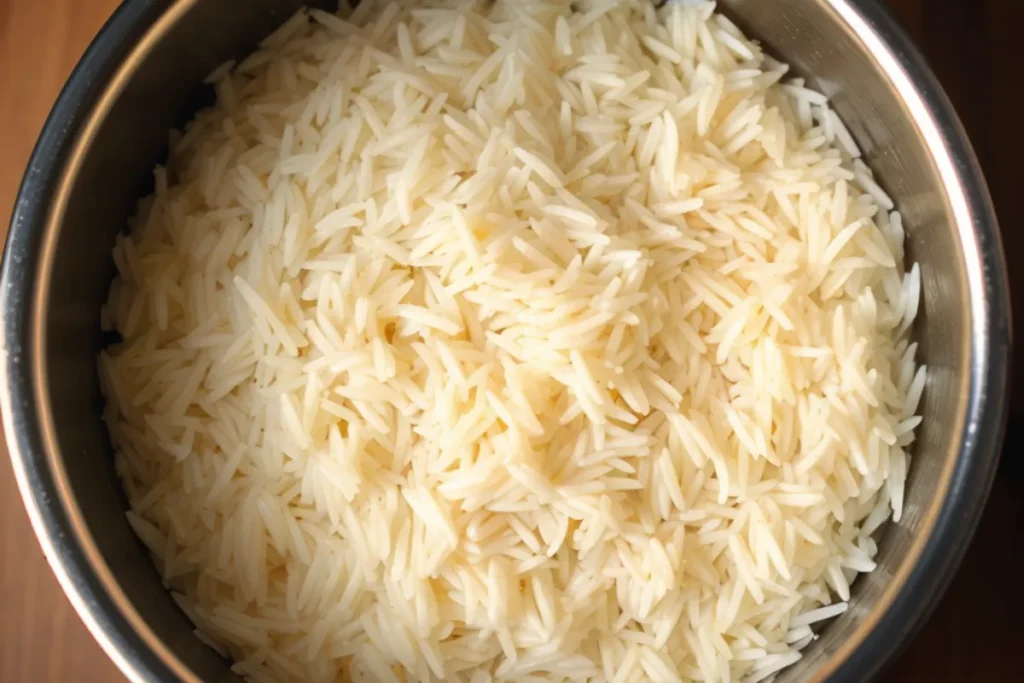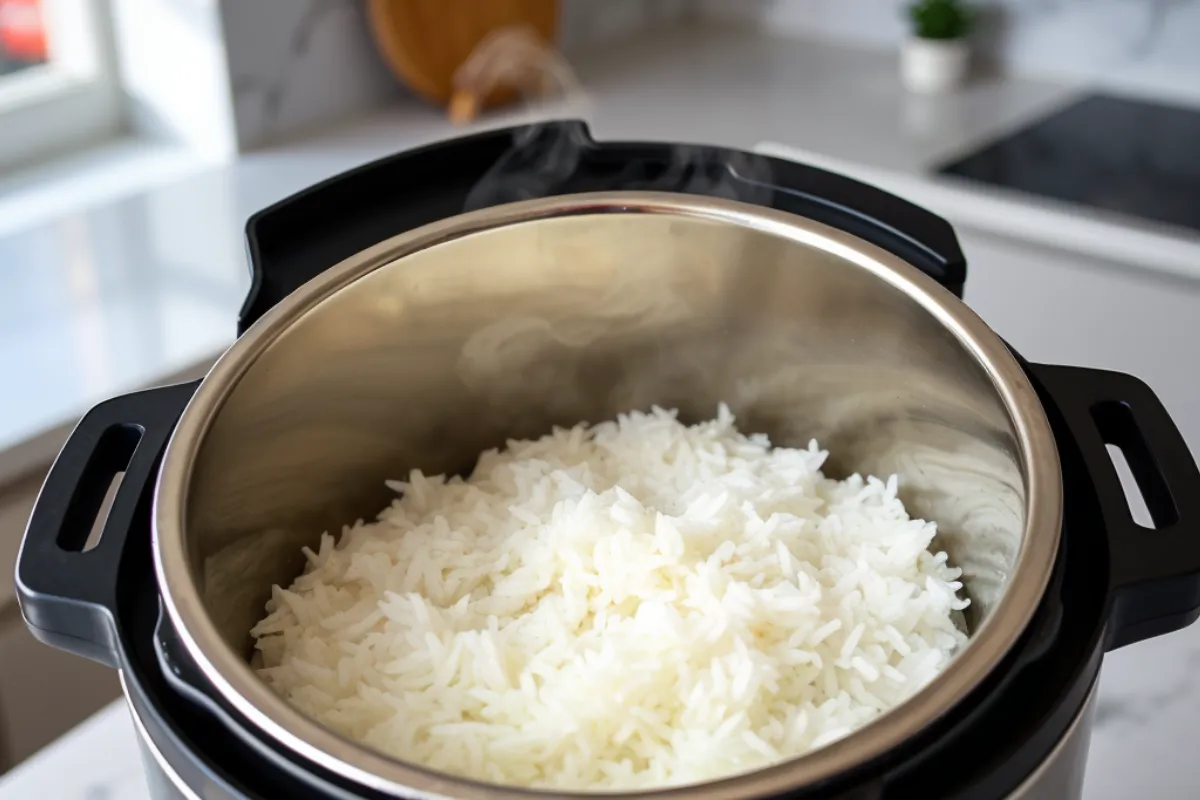If you’ve ever found yourself asking, “Why is my Instant Pot Basmati rice so sticky?” you’re not alone. While the Instant Pot is a fantastic tool for speeding up meal prep, cooking rice in it can sometimes result in sticky, clumpy grains rather than the fluffy, separate grains we all crave. Understanding the common mistakes and how to prevent them can transform your rice game. Let’s dive into why this happens and how to fix it.
Common Reasons for Instant Pot Sticky Rice
Incorrect Water-to-Rice Ratio
One of the most common culprits behind sticky rice is using too much water. Basmati rice, known for its long, slender grains, requires a specific water ratio to cook correctly. Unlike stovetop methods where water evaporates during cooking, the Instant Pot seals in moisture. If you use too much water, the rice absorbs it all, leading to mushy, sticky grains.
To avoid this, stick to the classic 1:1 ratio of water to rice for Instant Pot cooking. You can also adjust based on personal preference and the brand of rice you’re using.
Skipping the Rinsing Step
Rinsing rice before cooking is a crucial step that many skip. Unrinsed rice carries excess starch, which clings to the grains and contributes to the sticky texture. By rinsing the rice under cold water until the water runs mostly clear, you wash away that starchy layer, which is key to ensuring fluffy rice. For a detailed guide on rinsing and other tips, visit Basmati Rice Instant Pot: Perfect Guide & Tips.
This process is especially important for Basmati rice, where long, individual grains are prized. According to experts, removing this excess starch also helps reduce the risk of your rice becoming mushy. For more details on the health benefits and cooking tips for Basmati, you can check out Basmati Rice Health Benefits.
Not Using Natural Pressure Release
When cooking Basmati rice in an Instant Pot, it’s essential to allow the pressure to release naturally. A common mistake is opting for a quick pressure release, which can cause the rice to cook unevenly or become too wet. The natural pressure release gives the rice time to settle and absorb the remaining steam, ensuring an even, fluffy texture.
To perfect your rice, let the Instant Pot release pressure for about 10 minutes after the cooking cycle ends. This process ensures the rice finishes cooking without becoming sticky or overly soft.
How to Prevent Sticky Basmati Rice in an Instant Pot

Soaking the Rice
Another great way to reduce the stickiness of Instant Pot Basmati rice is to soak it beforehand. Soaking the rice for 15-30 minutes before cooking helps soften the grains and removes more starch. This technique results in less clumping and a fluffier texture. Although it may add an extra step to your process, it’s worth the effort for those perfect, separate grains.
Adjusting Cooking Fat
Adding a bit of ghee or oil to your rice before cooking can work wonders for texture. Not only does it enhance flavor, but it also helps prevent the grains from sticking together. A tablespoon of oil or butter stirred into the rice before sealing the Instant Pot can give your dish a subtle richness while keeping the grains light and airy.
Fluffing the Rice After Cooking
Once your rice is fully cooked, fluffing it is a crucial step. This simple act helps separate the grains and release any trapped steam. Use a fork to gently fluff the rice right after the pressure has released. Avoid using a metal spoon, as it can break the delicate grains and contribute to stickiness. Fluffing prevents the rice from overcooking in its own steam, ensuring a light and fluffy texture.
Fixing Instant Pot Sticky Rice: Simple Solutions
Drain Excess Water
If you’ve already cooked your rice and find it too sticky, don’t panic. One immediate solution is to drain any excess water. Pour the rice into a colander and allow the excess moisture to drain off. This can help salvage the texture and prevent the rice from becoming overly mushy.
Spread Out the Rice to Cool
Another quick fix is to spread the rice out on a large plate or baking sheet. This allows it to cool down faster and stops further cooking. By separating the rice grains on a flat surface, you can reduce stickiness and improve texture before serving.
By following these guidelines and adjusting your approach, you can consistently achieve the perfect, fluffy Basmati rice in your Instant Pot. Cooking rice isn’t as tricky as it seems—it just takes a bit of technique and practice.
Step-by-Step Guide to Cooking Perfect Basmati Rice in an Instant Pot

Cooking Basmati rice in an Instant Pot doesn’t have to be complicated. By following a simple, proven method, you can ensure your rice turns out perfectly every time. Here’s how:
- Rinse the Rice: Start by rinsing the rice under cold water until the water runs clear. This removes excess starch, which is crucial for preventing sticky rice.
- Soak (Optional but Recommended): Soak the rice for 15-30 minutes. This step helps soften the grains and reduces cooking time.
- Add Ingredients: Place the rinsed and drained rice into the Instant Pot. Add an equal amount of water (1:1 ratio), a pinch of salt, and a tablespoon of oil or ghee for added flavor and fluffiness.
- Set the Cooking Time: Seal the lid and set the Instant Pot to high pressure. Cook the rice for 6 minutes. For more details on cooking times, see How Long to Cook Rice in an Instant Pot.
- Natural Pressure Release: Once the cooking cycle is complete, allow the pressure to release naturally for 10 minutes. This step is critical for achieving perfectly cooked, non-sticky rice.
- Fluff and Serve: Open the lid, fluff the rice with a fork, and serve.
By sticking to this method, you’ll avoid the common pitfalls of overcooked or sticky rice.
How to Adjust Water Based on Rice Type
Not all Basmati rice brands are created equal. The water absorption rate can vary slightly depending on the brand, age, and type of rice. Here’s how you can adjust:
- For Softer Rice: If you prefer softer rice, increase the water slightly—perhaps by a tablespoon or two. This adjustment adds moisture without making the rice sticky.
- For Firmer Rice: If you prefer a firmer texture, reduce the water by a tablespoon or two. This will result in a more al dente bite, which is ideal for dishes like biryani or pilaf.
Experiment with different ratios until you find the perfect balance for your preferred rice texture. For more in-depth guidance, you might explore resource like Perfect Rice with an Instant Pot.
Common Mistakes and How to Avoid Them
Even with the best intentions, mistakes can happen. Here’s how to troubleshoot and prevent some of the most common errors when cooking Instant Pot Basmati rice:
- Not Measuring Properly: Always measure your rice and water accurately. An incorrect ratio can lead to sticky or undercooked rice. Use the same measuring cup for both rice and water to maintain consistency.
- Skipping the Natural Release: As mentioned earlier, allowing the Instant Pot to release pressure naturally is vital. Skipping this step can leave your rice unevenly cooked and more prone to stickiness.
- Overcooking: Be mindful of the cooking time. Overcooking can break down the rice grains, resulting in a gummy texture. Stick to the recommended 6 minutes at high pressure, with a 10-minute natural release for best results.
By being aware of these common pitfalls and how to avoid them, you can ensure that your rice turns out perfectly every time.
Advanced Techniques for Perfect Basmati Rice
Using Ghee or Oil for Fluffier Rice
One simple yet effective technique to improve the texture of your Basmati rice is to add a small amount of ghee or oil before cooking. This addition helps keep the grains separate and adds a subtle richness to the flavor. Ghee, in particular, is a traditional choice in Indian cuisine, known for its nutty taste and ability to enhance the aroma of Basmati rice.
Sautéing the Rice Before Pressure Cooking
For an even fluffier texture, try sautéing the rinsed rice in oil or ghee using the sauté function of your Instant Pot before adding water. This step lightly toasts the rice, enhancing its nutty flavor and helping to create distinct, separate grains.
- Steps to Sauté:
- Rinse and drain the rice as usual.
- Set the Instant Pot to sauté mode.
- Add a tablespoon of oil or ghee and let it heat up.
- Add the rice and sauté for 2-3 minutes until the grains are lightly toasted.
- Add water and proceed with the usual cooking instructions.
This method is especially effective for dishes where you want the rice to stand out, such as pilafs or biryanis.
Alternative Methods for Cooking Basmati Rice

Boiling Method vs. Instant Pot
While the Instant Pot is a convenient and quick way to cook Basmati rice, the traditional boiling method still holds its own. In the boiling method, rice is cooked in a large amount of water and then drained, similar to pasta. This method is virtually foolproof for avoiding sticky rice because the excess starch is drained away with the water.
- Advantages:
- Easier to control the texture
- Lower risk of sticky rice
- Suitable for large batches
However, the Instant Pot remains superior for its speed and convenience, especially when you’re pressed for time.
How to Use a Rice Cooker for Non-Sticky Rice
Another alternative is the rice cooker, which is specifically designed for cooking perfect rice every time. The key is to use the right water-to-rice ratio and to follow the manufacturer’s instructions carefully.
- Tips for Success:
- Use the cup provided by the rice cooker for measuring both rice and water.
- Rinse the rice thoroughly before cooking.
- Allow the rice to rest in the cooker for a few minutes after cooking before opening the lid and fluffing.
Rice cookers are particularly useful for those who cook rice frequently and want consistent results without much fuss.
FAQs
Why is my Basmati rice mushy after using the Instant Pot?
Mushy rice often results from using too much water or overcooking. Stick to a 1:1 ratio of water to rice and ensure you’re not adding extra cooking time.
Should I rinse Basmati rice before cooking in the Instant Pot?
Yes, rinsing is crucial for removing excess starch, which can cause the rice to stick together. Always rinse until the water runs clear.
Can I cook Basmati rice without soaking?
Yes, soaking isn’t mandatory but it does help make the rice softer and less likely to stick. If you skip soaking, make sure to rinse thoroughly.
How do I fix overcooked rice in the Instant Pot?
If your rice is overcooked, spread it out on a flat surface to cool. This stops the cooking process and helps reduce stickiness.
How much water should I use for 1 cup of Basmati rice in the Instant Pot?
The standard ratio is 1 cup of water to 1 cup of rice. This ratio may need slight adjustment based on the brand of rice and your texture preference.
Mastering the art of cooking Basmati rice in your Instant Pot involves understanding the nuances of your device and the type of rice you’re using. By following these tips and techniques, you’ll consistently enjoy fluffy, non-sticky rice that’s perfect for any dish.

